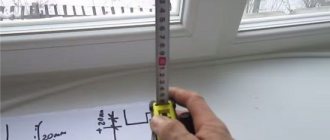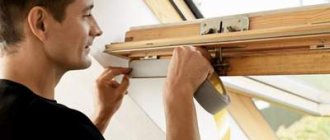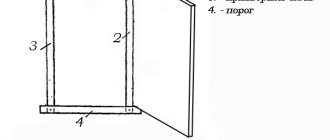To eliminate malfunctions, you need to adjust the plastic windows. To do this, you can call specialists, or you can do everything yourself, following the instructions.
A prerequisite for the effective performance of the functions of a plastic window is correct adjustment. It maintains the tightness of the rebate, the necessary tightness, and the smooth movement of the sash without distortions or touching the frame. The initial adjustment of plastic windows is carried out by installers during their installation. After this, they should work without defects or irregularities. However, over time, small gaps appear and the sashes begin to sag a little. In the future, these deviations intensify, which interferes with the normal operation of the structure.
What tools will you need?
To adjust plastic windows yourself, you will need a fairly simple kit, including:
- Hex wrench No. 4;
- Pliers;
- Phillips and flat screwdrivers;
- A screwdriver with a set of bits of different shapes.
The tools from this set are usually always available at home. An exception may be a hexagon, without which the work cannot be completed - this is the main regulatory tool. If you don’t know what key is needed to adjust plastic windows and where you can find it, then contact any furniture hardware store. 4 mm hexagons are used when assembling any modern cabinet furniture, so finding such a key will not be a problem.
A screwdriver and screwdrivers will be needed to work with the screw connections with which the hardware elements are attached to the profile. Pliers are needed as an auxiliary tool.
It is recommended to additionally prepare silicone grease for the fittings. You can also use WD-40 or other similar spray lubricants.
Seasonal adjustment: winter and summer mode
In the window design, the sash pressure can be adjusted. The window mechanism allows for self-adjustment. Before the start of the warm period, the window is switched to summer mode. This improves ventilation. Before snowfalls and frosts begin, the pressure should be strengthened, and the level of pressure should be checked with a match. If the wind leaks in, the flame will flutter. Changeover between summer and winter modes is carried out by acting on the eccentrics. Maximum pressure can be achieved using a hexagon number 4. If the trunnion is smooth, then the blade is first removed, and then the part is rotated. Window designs from different manufacturers are adjusted differently. Sometimes it is necessary to tighten the screws, and in some cases, remove the sash. The same window manufacturer may have fittings from different manufacturers, so you should read the instructions for adjusting them.
Main components that need adjustment
Adjustment may be required for any moving elements of plastic window fittings, which include:
Bottom swivel hinge
Top hinge with tilt and turn mechanism
Locking pins
Do-it-yourself repair and adjustment of plastic windows may be required at several points. In particular, it may be necessary to adjust the sash vertically, horizontally, adjust its pressure to the frame, and set the lower angle correctly
Possible consequences of incorrect settings
The biggest trouble with incorrect adjustment is wide gaps through which it will leak. In the cold season, this is fraught with heat loss, which should not be allowed.
A distortion of the structure will lead to incorrect operation of the hinges, which, in turn, leads to their failure. This can also lead to damage to the window sill - traces of the affected profile will remain on it.
But you should not treat the adjustment as an operation with simple manipulations. Any movement can change the settings. And although the process itself is simple, it must be approached with great care.
Did you know that plastic windows can be adjusted this way? Perhaps you have already encountered such a process? Tell us in the comments. Save the article to bookmarks and share it on social networks.
When do you need to adjust plastic windows?
Adjustment of windows is required in case of any violations of their normal operation. The following signs may indicate the need for its implementation:
- Tight movement of the valves;
- Visible subsidence or distortion of the sashes;
- Violations of the tightness of the closure - cracks appear, blowing from the window;
- Switching modes is difficult;
- Loose or jammed handles;
If such signs are detected, it is not recommended to delay taking action. In most cases, you can adjust the plastic windows yourself and quickly restore their normal operation. If you do not make adjustments in a timely manner, soon enough you may encounter a serious malfunction of the window structure, which will cause a lot of inconvenience and require significant repair costs.
Replacing the seal
Sealing materials on plastic glazing are needed not only to soften the impact of the sash on the frame, but also to protect the room from cold, dust and noise. But after several years of use, the effectiveness of the seals decreases by 20-30%, which leads to the need to clean or replace them. By replacing the material, the homeowner will increase energy saving and noise insulation, and make closing and opening easier.
The need to replace seals is determined not by timing, but by the degree of wear. When the material stops being pressed tightly, drafts appear in the room even when the sash is closed. In winter, the room becomes colder. To replace, the old seal will have to be removed and a new one glued on.
The need to replace the seal is extremely rare. If it is blowing from under the window, you most likely need to adjust the pressing force of the sash.
Adjusting the pressure of a plastic window
Most often you have to adjust the pressure on the sash of a plastic window. This parameter characterizes the force with which the sash is pressed against the frame when closed. Pressing of the sash is ensured by locking trunnions located at its end part. When the handle is turned, the trunnions move vertically, entering or leaving the mating part located in the frame opening. When the axle completely extends beyond the mate, the sash is pressed against the frame with maximum force. The magnitude of this force is subject to adjustment.
It is recommended to adjust the pressure of plastic windows at least twice a year to switch to winter and summer mode. The maximum pressure is set for the winter. It provides increased tightness and prevents cold air from entering the room due to insufficient sash cover. However, strong pressure accelerates the wear of rubber seals, so it is recommended to loosen it in summer.
It is also necessary to adjust the pressure of the plastic window if there is a blow from the area where the sash adjoins the frame. The reason for this may be incorrectly adjusted pressure or wear of the seals. You can check the presence of draft using the flame of a match or a lighter brought to the window. If the flame fluctuates, adjustment is necessary.
The plastic window does not close tightly - how to adjust
To ensure that the sash closes tightly, you can adjust the pressure of plastic windows yourself according to the instructions.
The axle has an eccentric that needs to be turned in a certain direction to adjust the pressure of the PVC window. Depending on the model of fittings used, there are oval or cylindrical trunnions. In the first case, the adjustment is performed by turning the trunnion itself with pliers. When the oval is positioned in a vertical position, the minimum clamping force is ensured, and in a vertical position, the maximum is ensured.
More popular today are cylindrical pins, which have sockets at the end for a No. 4 hex wrench offset from the axis by 2 mm. In this case, you can adjust the pressure of the plastic window by turning the pin using a hex key. Turning to the left increases the pressure, and turning to the right weakens it. Maximum pressing is achieved when the eccentric is positioned in such a way that the key socket is located on the outer side of the sash. The minimum pressure is achieved in the reverse position of the eccentric - the key socket is located on the inside of the sash.
Another eccentric is located on the underside of the top hinge plate. It must be rotated similarly to the eccentrics of the trunnions around the perimeter of the sash. This will allow you to adjust the pressure in the top hinge area. To access this eccentric, the window must be open in two positions. First, you need to open the sash and switch it to ventilation mode by pressing the lock lever.
To evenly press the sash around the perimeter, all eccentrics on the trunnions must be in the same position. Uneven pressing accelerates wear of the seal and leads to a violation of the tightness of the closed window.
General principles for adjusting window sashes
The sashes of almost all modern PVC windows can be adjusted in three planes, thanks to which you can achieve the correct position of the sashes in the frame and achieve the optimal degree of pressing of the seals along the entire perimeter of the sash.
The methods for adjusting the sash fittings, the appearance of its individual elements and the tool used for adjustment may vary depending on the manufacturer, but in general the general adjustment scheme looks as shown in the figures below.
Figure 1 - General principles for adjusting PVC windows
Figure 2 - General scheme for adjusting a plastic window
Figure 3 - Various window adjustment options
Now let's look at what needs to be done to fix the problem in each of the above cases.
How to adjust a plastic window so it doesn't blow
In some cases, adjusting the window trunnion does not allow achieving the tightest possible pressure, and the closed sash continues to blow. This occurs when the sash moves vertically or horizontally. As a result, part of the trunnions may not completely extend beyond the mating part.
To determine the place where incomplete pressure is created, you need to remember the locations of the trunnions or make corresponding marks on the inside of the sash profile. After this, you need to close the window and, in the marked places, try to press the sash away from the frame with your hands. If it remains motionless, then the trunnion is working properly. If the sash moves, and a gap appears at the point where the force is applied, then the trunnion does not completely fit into the mating part. In such cases, additional adjustment of the plastic window sash horizontally and/or vertically is required.
Adjusting the plastic window horizontally
To eliminate slight distortion and displacement of the sash in the horizontal plane, you need to adjust the plastic window horizontally. This adjustment can be made on the upper and lower hinges, which have special hexagon sockets. Therefore, you can adjust the position of the sash using the same 4 mm hex key that was used to adjust the trunnions on plastic windows.
On the bottom hinge, access to the hexagon socket is available from the outside and inside. Thanks to this, you can adjust the window both open and closed. When you turn the key clockwise, the sash will move in the direction opposite to the hinge, while its lower corner on this side will rise. Turning the key counterclockwise causes the sash to move towards the hinge, and the lower corner on the opposite side is slightly lowered.
Horizontal adjustment of the plastic window sash can also be done on the top hinge. In this case, work is carried out only with the window open. On the hinge you need to find the hexagon socket and turn it with a key in the same way as working with the lower hinge.
These manipulations will allow you to move the upper or lower part of the sash horizontally up to 2 mm. It is recommended to adjust the sash with limited displacements - no more than 1 mm per turn of the key.
Adjusting the plastic window vertically
Self-adjustment of plastic windows vertically is performed on the lower hinge. The required hexagon hole is located at the top of the hinge, so to access it you need to remove the decorative plastic cap. For ease of adjustment, it is recommended to switch the window to ventilation mode. Turning the key clockwise raises the sash, and counterclockwise causes it to lower.
As with the horizontal adjustment, the window sash movement range is 2 mm.
Possible errors and difficulties
When adjusting the hinge mechanism of a PVC structure, beginners may encounter a number of difficulties:
- Tight movement of the adjustment screw when turning with a screwdriver or wrench. This problem indicates low quality or lack of maintenance of the fittings over a long period of time. Before making adjustments, all metal parts should be treated with a penetrating lubricant to facilitate the sliding of the metal.
- Turning the adjusting screw should be done using hand tools only. A highly sensitive mechanism ensures that the element moves with each rotation of the part by 90-180 degrees, and therefore the use of a screwdriver will not allow achieving increased accuracy.
- If, after making the adjustment, the sash opens with a crunch, this indicates a lack of synchronization between the positions of the upper and lower suspension, which must be eliminated immediately after identifying the problem.
If, after completing the adjustment, the sash does not meet the requirements for comfortable operation, you should seek help from professionals. Such malfunctions indicate a breakdown of individual mechanisms and the need to replace them as soon as possible.
Replacing the handle and adjusting the fittings of a plastic window
In addition to insufficient pressure and airflow, other problems may arise in the operation of a plastic window. Often during operation, problems may arise with turning the handle, which moves slowly when switching modes or even gets stuck in a certain position. Therefore, owners need to know how to properly adjust plastic windows themselves in such cases.
One of the common causes of such problems is a faulty handle. Most often it just becomes loose and starts to wobble. In case of such a malfunction, it is enough to tighten the fastening screws. To access the screws, you need to pry the decorative plastic trim on the handle body from above and below with your fingers and turn it horizontally.
Stiffness of the handle can be caused by clogging of its mechanism. To remove dirt, the handle must be removed by unscrewing the fastening screws and cleaned with a brush or vacuum cleaner. It is recommended to lubricate the seat of the handle inside the door with WD-40 aerosol lubricant with a nozzle. Another reason why the handle turns tightly may be that the sash is being pressed tightly. If it is not necessary to maintain maximum pressure, it is recommended to adjust the trunnions by reducing the force.
If the handle does not turn at all, this is most often due to incorrect operation of the lock, which is designed to prevent it from turning when the sash is open. To unlock the handle, you need to find the lock and release it. Depending on the model of fittings used, the blocker can be made in the form of a clip that fits onto the seal, or in the form of a shaped plate screwed at an angle to the seal.
The solution to the problem in case of severe wear is to replace the handle. You can find a new part in almost any hardware store or order it from a window manufacturing company. All handles have a standard design, so there will be no problems with selecting a suitable element. After this, you just need to dismantle the old handle and put a new one in its place.
Problems with windows that you can solve yourself
Troubleshooting some hardware problems is a task for specialists. When doing repairs yourself, there is a risk of damage to the sash mechanisms, and even the entire glass unit. However, in most cases, repairs and adjustments can be performed by you without contacting specialists. The list of tasks that are easy to perform includes: 1. Setting the mode for winter or summer. Modern models make it possible to quickly and easily adjust winter and summer plastic windows in order to function better at different times of the year. 2. Setting the sash to “catch” the frame when closing. 3. Adjustment of the moving parts of the window unit when the structure is jammed in the open position or the plane does not fit tightly to the window seal. 4. Replacement of the rubber seal, which leads to seal failure. It is performed on average every 5-7 years, as it wears out. 5. Elimination of the problem with the activation of the erroneous action blocker. Occurs when the handle is accidentally turned if the sash is slightly open. The upper part in this case falls out when opening. The handle is blocked, but the sash does not close, sagging on one hinge. 6. Adjusting the handle, which can become loose or, conversely, jam.
In order to encounter fewer problems, you should immediately choose high-quality and inexpensive plastic window blocks that have good fittings. Moreover, low-quality plastic can warp and lose shape, making it impossible to close the window. Instead of repairing such glazing, problems will often have to be solved only by replacement.
The plastic window closes tightly - how to adjust
If the plastic window does not close well, self-adjustment will also help eliminate the problem. The reason is usually the misalignment of the sash, as a result of which it touches the frame when opening or closing. To solve the problem, you need to eliminate the skew by adjusting vertically or horizontally. First of all, you need to carefully inspect the window to determine the place where the sash comes into contact with the frame. Contact between surfaces usually occurs on the bottom edge or on the side edge of the sash on the side opposite the hinges.
If the sash rubs the frame from below, it must be moved up and towards the corner adjacent to the top hinge. To adjust a metal-plastic window with your own hands, you need to open the sash and turn the adjusting screw of the top hinge clockwise a few turns. After this, you need to close the sash, remove the decorative cap from the lower hinge, insert the hex key into the hole of the adjusting lift and turn it several turns clockwise. After adjusting the PVC window, you need to check the movement of the sash. If necessary, repeat the manipulations.
If the sash comes into contact with the frame when opening and closing, then adjusting the fittings of a plastic window with your own hands involves moving it towards the hinges. If there is friction only on the lower side of the side edge, it will be enough to tighten the adjusting screw, which is located in the lower part of the lower hinge on the side, with a hex wrench. If the sash rubs the frame along the entire height of the side surface, then it must be moved additionally towards the upper hinge. To do this, you will have to tighten the adjusting screws on both hinges. After completing the work, you need to check the movement of the sash. If its friction on the frame is not completely eliminated, the adjustment manipulations must be repeated.
Adjusting the top hinge
Adjusting the top hinges usually raises the bottom corner on the window handle side.
This allows you to compensate for the subsidence of the structure, which causes it to cling to the frame. Procedure: 1. Rotate the adjusting screw clockwise, without unscrewing it completely, so that the edge does not cling to the mechanism and interfere with closing.
2. Continue turning, controlling the clearance and angle rise. 3. If you need to lower the upper corner, perform the same actions, changing the direction of rotation - counterclockwise. The pressure for the top hinge will not have to be adjusted on all sashes, but only on the folding ones. To gain access, you will have to open the window and turn the handle to set the ventilation mode. This will allow you to get to the hexagon responsible for the clamping force.
When making adjustments, you should hold the moving part of the structure, the load from which falls on the lower hinge.
PVC window lubrication
A significant part of the violations that require adjustment of the mechanism of plastic windows occurs due to its poor lubrication. In new windows, the fittings are coated with a sufficient amount of lubricant for effective operation. However, over time, these compounds degrade and lose their properties. These processes occur especially intensively in houses that are located near busy highways, industrial enterprises, and other sources of air pollution. Dust settles on the moving elements of window fittings and penetrates the lubricant, which significantly deteriorates its quality. This leads to jamming of the mechanisms and their accelerated wear. Therefore, adjusting old plastic windows always involves lubricating them.
To prevent accelerated wear of fittings and complex repairs, you need to lubricate them at least once a year. It is best to lubricate windows twice a year - before the onset of the winter and summer seasons. In addition, it is recommended to lubricate after carrying out any maintenance work on any hardware elements, for example, after adjusting the scissors of a plastic window, hinges or pins.
What to lubricate with?
Special compounds are used as lubricants for servicing plastic windows, which are sold in specialized stores or can be ordered from window suppliers. They are supplied in bottles with convenient attachments designed to work with certain elements of fittings. If such special lubricants are not at hand, you can use technical petroleum jelly and any technical oils, for example, sewing machine oil. Silicone grease or aerosol lubricants such as WD-40 can also be used. The use of edible, cosmetic and other types of oils that are not intended for use with mechanisms is not allowed.
To achieve maximum beneficial effect, the lubricant should be applied to clean and dry metal surfaces. Therefore, after adjusting the window fittings, it must be thoroughly cleaned of any dirt and wiped with a soft cloth. Dirt from hard-to-reach places is removed with a brush or sponge. Before applying the lubricant, it is recommended to further inspect the window fittings to ensure they are clean.
What to lubricate?
Lubricant is applied to all moving elements. Lubricated including:
- Trunnions;
- “Scissors” of a plastic window;
- Hinge adjustment mechanisms;
- Fastenings;
- Latches, etc.
A few drops of lubricant are applied to each of the moving parts. After this, I let the mechanism work in normal mode to distribute the lubricant evenly.
In addition to the mechanisms, rubber seals must be lubricated. For this, a special composition is used. The lubricant maintains the elasticity of the rubber and prevents it from drying out. It is better to treat seals twice a year. Be sure to lubricate them in the fall when adjusting the pressure of a plastic window with your own hands in winter mode.
Regular lubrication of window fittings will extend its service life and eliminate unnecessary repairs and adjustments. In some cases, it serves as an alternative to adjustment work. For example, before adjusting plastic windows that do not close well, it is recommended to lubricate the fittings. In many cases, this is enough to solve the problem.
The importance of winter-summer modes
Despite the fact that in warm weather the windows are opened for ventilation, adjustment of the sash in summer mode is required to create a good microclimate in the room. It is also effective when there is a need to leave for a certain period of time. Then there will be no musty smell in the house due to a small draft through the cracks of the sash. When setting modes, you should lubricate the mechanisms with machine oil or Vaseline so that their operation is smooth and of high quality.
Experts recommend adjusting the pressure density to the winter position gradually to reduce the load on the seal and not deform it. Before this, you should thoroughly clean the window frame from dust and debris, which can form a draft due to the loose fit of the sash. In winter, blowing is excluded, so the tightness of the closure is checked with a lit match. Its attenuation or fluctuation of fire indicates the presence of cold bridges.
Instructions for adjusting hinges
As you know, a plastic window does not have a window. Therefore, ventilation is carried out by tilting the sash. However, as a result, a gap that is too large is formed, and cold air quickly fills the room. How to reduce the gap? In fact, you can do this yourself.
To do this, the loop pressure is corrected. To eliminate drafts, you first need to find a place for ventilation. If it is located in the lower hinge area, you need to take a hexagon, remove the cap and adjust according to the instructions.
First, you should set the sash to ventilation mode. With the window closed, it is not possible to get to this screw, which is responsible for the level of pressure on the hinges.
Some plastic windows have locks that prevent the window from opening. To do this, you need to lift the plate located at the base of the handle and turn it 90 degrees in any direction. As a result, screws will appear in front of you, which should be tightened to the maximum using a screwdriver.











